Winning show designs are characterized by their ability to create immersive experiences that captivate audiences while emphasizing sustainability and technological integration. By understanding audience needs and effectively utilizing space, designers can craft memorable events that resonate deeply with attendees. Key elements such as visual storytelling, lighting, and sound design further enhance these experiences, ensuring that the overall message is both impactful and engaging.
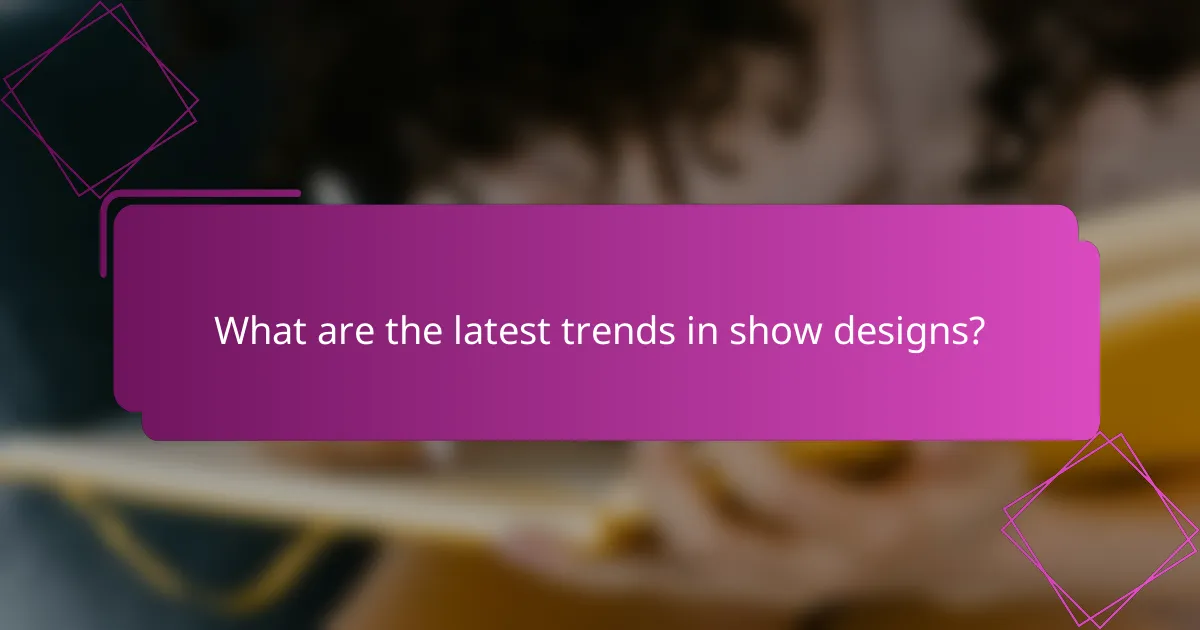
What are the latest trends in show designs?
The latest trends in show designs focus on creating engaging and memorable experiences through immersive environments, sustainable practices, and the integration of interactive technology. These elements not only enhance audience engagement but also reflect a growing awareness of environmental impact and technological advancements.
Immersive experiences
Immersive experiences in show designs aim to fully engage the audience’s senses, often using multi-sensory elements such as sound, visuals, and even scents. This trend encourages designers to create environments where attendees feel part of the narrative, enhancing emotional connections to the content.
For example, events may utilize 360-degree projections or augmented reality to transport audiences to different settings. Consider incorporating themed spaces that allow for exploration and interaction, which can significantly elevate the overall experience.
Sustainable materials
Using sustainable materials in show designs is increasingly important as environmental concerns grow. Designers are now prioritizing eco-friendly options such as recycled fabrics, biodegradable plastics, and sustainably sourced wood to minimize the ecological footprint of their events.
When selecting materials, consider durability and reusability to reduce waste. For instance, modular structures made from recycled materials can be reused for multiple events, providing both cost savings and environmental benefits.
Interactive technology
Interactive technology is transforming show designs by allowing audiences to engage directly with the content. This can include touch screens, mobile apps, and social media integration, enabling real-time feedback and participation.
Incorporating interactive elements can enhance audience involvement and satisfaction. For example, live polls or Q&A sessions through apps can foster a sense of community and encourage dialogue, making the experience more dynamic and memorable.
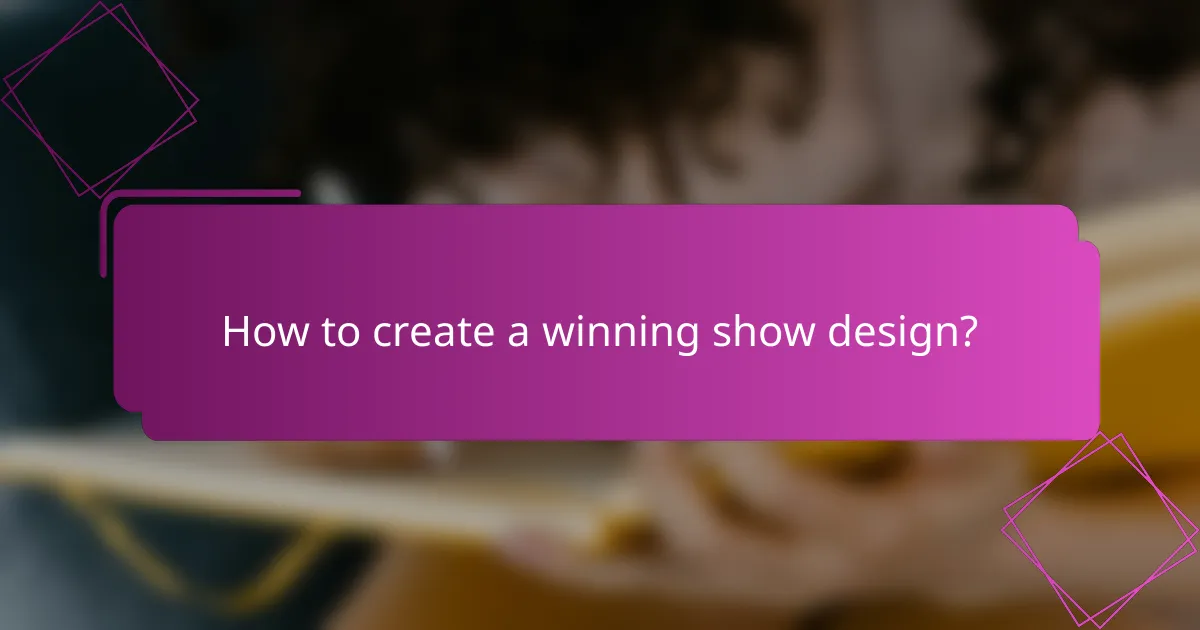
How to create a winning show design?
Creating a winning show design involves understanding your audience, integrating brand identity, and utilizing space effectively. These elements work together to create an engaging and memorable experience that resonates with attendees.
Define your audience
Understanding your audience is crucial for effective show design. Identify their demographics, preferences, and interests to tailor the experience accordingly. Consider factors such as age, profession, and cultural background to ensure your design speaks to them.
Conduct surveys or focus groups to gather insights about what your audience values in a show. This information can guide decisions on themes, layouts, and interactive elements that will engage them most effectively.
Incorporate brand identity
Your show design should reflect your brand’s identity and values. Use consistent colors, logos, and messaging throughout the design to reinforce brand recognition. This creates a cohesive experience that aligns with your marketing efforts.
Consider how elements like typography and imagery can convey your brand’s personality. For instance, a tech company might opt for sleek, modern designs, while a vintage brand may choose classic, nostalgic elements.
Utilize space effectively
Effective use of space is essential for creating a functional and inviting show design. Plan the layout to facilitate smooth traffic flow and ensure that key areas, such as displays or stages, are easily accessible. Aim for a balance between open areas and designated spaces for activities.
Incorporate flexible seating and standing areas to accommodate different audience sizes and preferences. Use visual cues, such as signage and lighting, to guide attendees through the space and highlight important features.
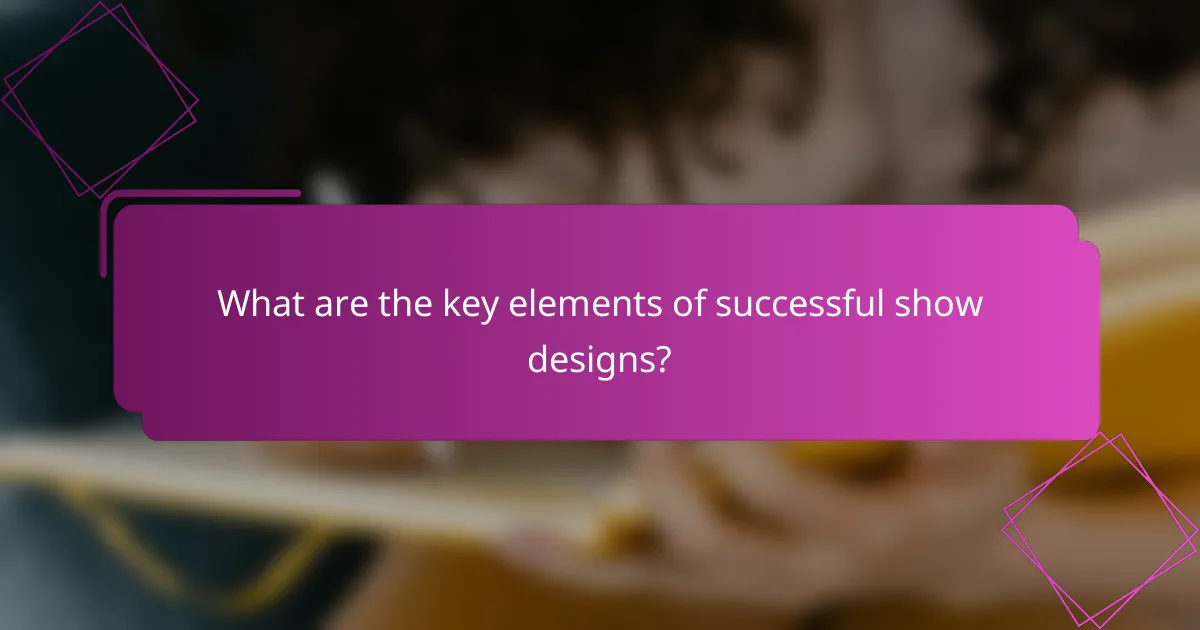
What are the key elements of successful show designs?
Successful show designs hinge on a few critical elements, including visual storytelling, lighting and sound design, and engagement strategies. Each of these components plays a vital role in creating an immersive experience that captivates the audience and enhances the overall message of the show.
Visual storytelling
Visual storytelling is the art of conveying a narrative through images, colors, and design elements. It involves creating a cohesive visual theme that aligns with the show’s message and resonates with the audience. Effective visual storytelling can evoke emotions and establish a connection, making the experience memorable.
When planning visual elements, consider using a consistent color palette and typography that reflects the theme. Incorporating multimedia elements like video projections or interactive displays can also enhance storytelling. Aim for clarity and coherence to ensure the audience easily follows the narrative.
Lighting and sound design
Lighting and sound design are crucial for setting the mood and enhancing the atmosphere of a show. Proper lighting can highlight key moments, create depth, and influence the audience’s emotional response. Similarly, sound design, including music and sound effects, can amplify the storytelling and engage the audience on a deeper level.
When designing lighting, consider using a mix of ambient, accent, and task lighting to create dynamic scenes. For sound, ensure that audio levels are balanced and that any music or effects align with the visual elements. Testing these components in advance can help avoid technical issues during the performance.
Engagement strategies
Engagement strategies are essential for keeping the audience involved and invested in the show. These can include interactive elements, audience participation, and social media integration. By fostering a connection between the performers and the audience, you can enhance the overall experience and encourage lasting memories.
Consider incorporating elements like live polls, Q&A sessions, or interactive displays that allow audience members to contribute. Additionally, leveraging social media platforms can extend the engagement beyond the event itself, encouraging attendees to share their experiences and connect with others. Always be mindful of the audience’s preferences and comfort levels when implementing these strategies.
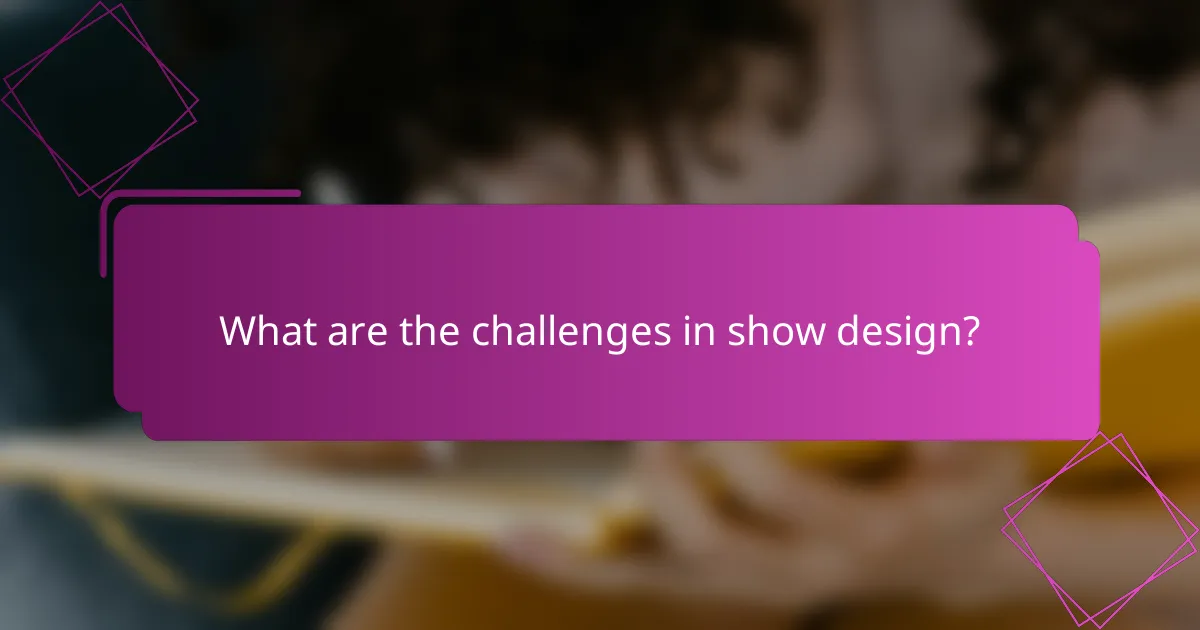
What are the challenges in show design?
Show design presents several challenges that can impact the overall success of an event. Key issues include budget constraints, time management, and technical limitations, each requiring careful consideration and strategic planning.
Budget constraints
Budget constraints are a primary challenge in show design, affecting every aspect from venue selection to production quality. Designers must prioritize elements that deliver the greatest impact while staying within financial limits.
To manage budget constraints effectively, consider creating a detailed budget plan that outlines all expected costs, including venue, equipment, and staffing. Regularly review and adjust this plan to avoid overspending.
Time management
Time management is crucial in show design, as tight schedules can lead to rushed decisions and compromised quality. Effective planning and clear timelines help ensure that all tasks are completed on schedule.
Utilize project management tools to set deadlines and track progress. Break down the design process into manageable phases, allowing for flexibility to address unforeseen delays without jeopardizing the overall timeline.
Technical limitations
Technical limitations can significantly impact show design, including restrictions related to equipment, venue capabilities, and technology integration. Understanding these limitations early in the planning process is essential for creating a feasible design.
Conduct a thorough assessment of the venue’s technical specifications and available resources. Collaborate closely with technical teams to explore innovative solutions that can work within these constraints, ensuring a seamless execution of the show.

How do cultural influences shape show designs?
Cultural influences significantly shape show designs by dictating aesthetic choices, thematic elements, and audience engagement strategies. Designers must consider local customs, values, and historical narratives to create resonant experiences that appeal to diverse audiences.
Regional aesthetics
Regional aesthetics play a crucial role in defining the visual language of show designs. For instance, a show in Japan may incorporate minimalistic elements and natural materials, reflecting traditional Japanese design principles, while a show in Brazil might emphasize vibrant colors and dynamic patterns, showcasing the country’s rich cultural heritage.
Designers should research local art forms, architecture, and fashion trends to ensure that their designs resonate with the regional audience. This approach not only enhances the show’s appeal but also fosters a deeper connection with the community.
Audience expectations
Understanding audience expectations is vital for successful show designs. Different cultures have unique preferences regarding storytelling, pacing, and interactivity. For example, audiences in Western countries may favor fast-paced narratives, while audiences in Eastern cultures might appreciate slower, more contemplative storytelling.
To meet these expectations, designers should gather feedback through surveys or focus groups before the show. This insight can guide decisions on elements like pacing, humor, and emotional tone, ensuring that the design aligns with what the audience anticipates.
Historical context
Historical context influences show designs by providing a backdrop against which cultural narratives unfold. Designers must consider significant historical events, figures, and movements that shape the identity of the audience. For example, a show in Germany might draw on themes from the Bauhaus movement, reflecting the country’s architectural legacy.
Incorporating historical references can enrich the narrative and offer audiences a sense of familiarity and connection. Designers should strive to weave these elements into their work, creating layers of meaning that resonate with viewers’ collective memories and experiences.
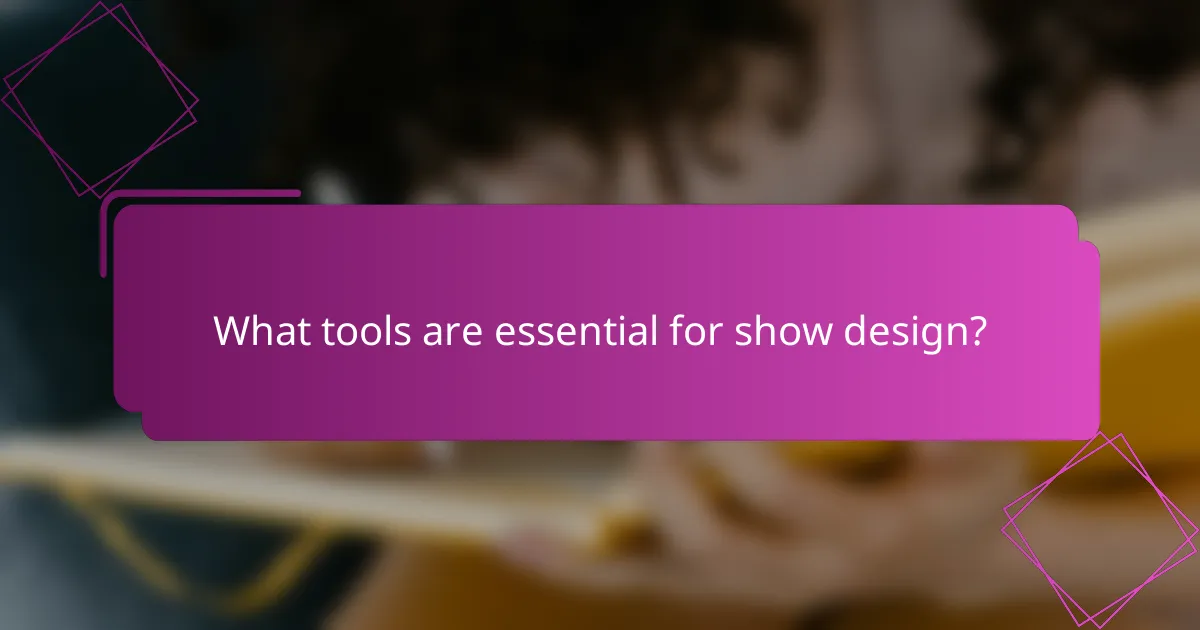
What tools are essential for show design?
Essential tools for show design include software for planning, visualization, and execution. These tools help designers create immersive experiences, manage logistics, and collaborate effectively with teams.
Design Software
Design software is crucial for creating visual representations of the show. Popular options include AutoCAD for detailed layouts, SketchUp for 3D modeling, and Adobe Creative Suite for graphics and presentations. Each tool has its strengths, so choosing the right one depends on the specific needs of the project.
Project Management Tools
Project management tools help streamline communication and task management among team members. Software like Trello or Asana allows for tracking progress, assigning tasks, and setting deadlines. Utilizing these tools can prevent miscommunication and ensure that everyone is aligned on objectives.
Lighting and Sound Equipment
Lighting and sound equipment are vital for creating the desired atmosphere during a show. This includes stage lights, microphones, and sound mixers. Investing in quality equipment can significantly enhance the audience’s experience and ensure that performances are delivered flawlessly.
Budgeting Tools
Budgeting tools assist in managing finances throughout the show design process. Software like QuickBooks or Excel can help track expenses, forecast costs, and manage cash flow. Keeping a close eye on the budget is essential to avoid overspending and ensure the project remains financially viable.
